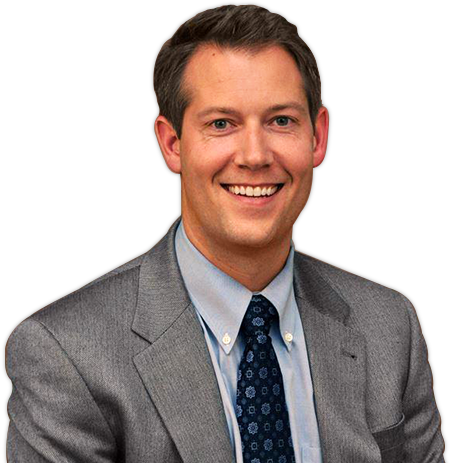Shoulder Instability
Anterior Instability Repair
General Instructions
- Therapy is to being 2 weeks after the surgery.
- The patient should work with their therapist 1-3X per week until released by the surgeon.
- Do not add or skip any part of this program. If you have concerns please contact my office.
- Goals: The 2 main goals of this physical therapy program are to:
- Have full active and passive range of motion by 3 months after surgery
- Return to sport by 18-24 weeks after surgery
Sling Wear
- Patients must wear their sling at all times for the first 6 weeks after surgery, this does include while they are sleeping. Patients may only remove the sling to perform therapy exercises and for showering.
Ice
- The use of ice or ice machine is encouraged to help control pain and inflammation after surgery.
Questions/Concerns:
- Therapists – if you have questions or concerns, please contact me directly or my office. Email is best for non-urgent issues: [javascript protected email address]
Protocol
All time points are based on time since surgery:
0-2 Weeks
- Wrist and Elbow ROM Only
2 Weeks
- Passive/active assist forward elevation (FE) to 90 degrees
- Passive/active assist external rotation (ER) to neutral with arm at the side
- Gentle Isometrics (no ER/IR)
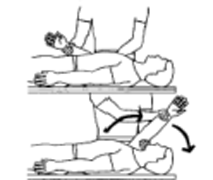
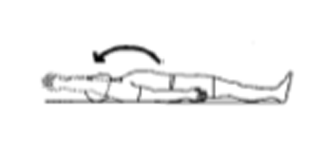
4 Weeks
- Passive/active assist forward elevation (FE) to 120 degrees
- Passive/active assist external rotation (ER) to 20 degrees with arm at the side
- Passive/active assist Abduction to 90 degrees
- Scapula protraction/retraction (with arm in sling until 6 weeks post-op)
- No combined Abduction and ER!
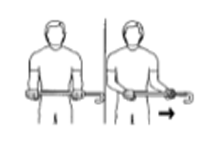
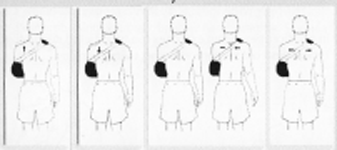

6 Weeks
- May discontinue sling usage, unless in crowd, or on slippery surfaces
- Unlimited passive/active assist in FE
- May being active motion in all planes
- Posterior glides OK (no anterior)
- Resisted isometrics (no IR)
8 Weeks
- Continue to progress with active motion
- May slowly progress to resisted exercise with therabands
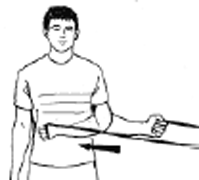
12 Weeks
- May begin sport specific exercises
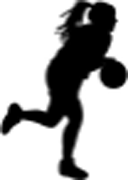
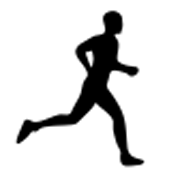
18-24 Weeks
- Return to play with approval of surgeon
Posterior Instability Repair
General Instructions
- Therapy is to being 2 weeks after the surgery.
- The patient should work with their therapist 1-3X per week until released by the surgeon.
- Do not add or skip any part of this program. If you have concerns please contact my office.
- Goals: The 2 main goals of this physical therapy program are to:
- Have full active and passive range of motion by 3 months after surgery
- Return to sport by 18-24 weeks after surgery
Sling Wear
- Patients must wear their sling at all times for the first 6 weeks after surgery, this does include while they are sleeping. Patients may only remove the sling to perform therapy exercises and for showering.
Ice
- The use of ice or ice machine is encouraged to help control pain and inflammation after surgery.
Questions/Concerns:
- Therapists – if you have questions or concerns, please contact me directly or my office. Email is best for non-urgent issues: [javascript protected email address]
Protocol
All time points are based on time since surgery:
0-2 Weeks
- Wrist and Elbow ROM Only
2 Weeks
- Passive/active assist forward elevation (FE) to 90 degrees


4 Weeks
- Passive/active assist forward elevation (FE) to 120 degrees
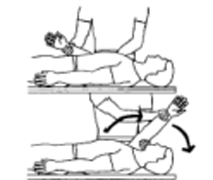
- Passive/active assist Abduction to 90 degrees
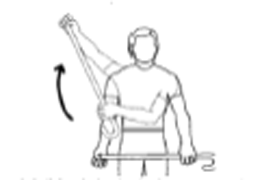
- Isometrics – no External Rotation (ER)
- No combined Abduction and IR!
6 Weeks
- May discontinue sling usage, unless in crowd, or on slippery surfaces
- Unlimited passive/active assist in FE
- May being active motion in all planes – to remain less than passive limits
- Resisted isometrics (no ER)
- PRE’s – No ER/IR
- Scapular stabilizers – protraction/retraction
- Anterior glides OK if needed – no posterior
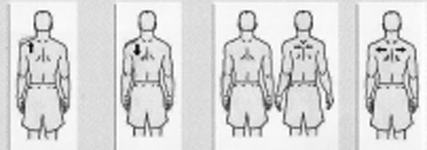
8 Weeks
- Passive/active assist internal rotation to 30 degrees with arm at the side
- Passive/active assist internal rotation at 45 degrees abduction to 30 degrees
- Continue to progress with active motion
- May slowly progress to resisted exercise with therabands

10 Weeks
- Unlimited internal rotation – passive and active
- PRE’s – with IR/ER
14 Weeks
- May begin sport specific exercises


- Posterior glides OK if needed
20-24 Weeks
- Return to play with approval of surgeon
Latarjet (Coracoid Transfer)
Phase I (Weeks 0-4): Protect Repair
- Sling to be worn at all times except for showering and rehab under guidance of PT
- Range of Motion – True Supine Passive Range of Motion Only to Patient Tolerance
- Goals: 140° Forward Flexion, 25° External Rotation in the 30° abducted position, 60-‐80° Abduction in the plane of the scapula without rotation, Limit Internal Rotation to 45° with the shoulder in the 30°abducted position
- Maintain elbow at or anterior to mid-axillary line when patient is supine
- Therapeutic Exercise – No canes or pulleys during this phase
- Codman Exercies/Pendulums
- Elbow/Wrist/Hand Range of Motion and Grip Strengthening
- Isometric Scapular Stabilization
- Heat/Ice before and after PT sessions Phase II (Weeks 4-10)
Phase II (Weeks 4-10): Protect Repair/ROM
- Discontinue sling immobilization at 6 weeks post-op
- Range of Motion
- 4-6 weeks: PROM - FF and Abduction to tolerance, 45° External Rotation in the 30° abducted position
- 6-10 weeks: Begin AAROM and AROM as tolerated: ER/IR to tolerance
- Goals: FF/Abduction > 155⁰, ER/IR >75⁰ at 90⁰ of shoulder abduction
- Therapeutic Exercise
- 4-6 weeks: Being gentle AAROM exercises (supine position), gentle joint mobilizations (grades I and II), continue with Phase I exercises
- 6-10 weeks: Progress to active exercises with resistance, shoulder flexion with trunk flexed to 45° in upright position, begin deltoid and biceps strengthening,
- Modalities per PT discretion
Phase III (Weeks 10-16): Full restoration of ROM
- Range of Motion – Progress to full AROM without discomfort
- Therapeutic Exercise
- Continue with scapular strengthening
- Continue and progress with Phase II exercises
- Begin Internal/External Rotation Isometrics
- Push up plus (wall, counter, knees on floor, floor)
Phase IV (Months 4-6): Strengthening/Return to Sports
- Range of Motion – Full without discomfort
- Therapeutic Exercise – Advance strengthening as tolerated: isometrics > therabands > light weights
- 8-12 repetitions/2-3 sets for Rotator Cuff, Deltoid and Scapular Stabilizers
- Return to sports at 6 months if approved
- Modalities per PT discretion
Non-operative Shoulder Dislocation
Rehab Guidelines
First Time Dislocators: May be immobilized for 4-6 weeks before starting physical therapy. Recurrent Dislocators: Physical therapy can begin immediately
Phase I: 0-4 weeks (typically)
Goals:
- Re-establish full motion
- Prevent muscular atrophy
- Decrease pain and inflammation
- Allow capsular healing
- AAROM with wand to tolerance
- Begin IR/ER at side, progress to 30, 60, then 90 AB as pain subsides
- Submax isometrics for all shoulder musculature
- Gentle joint mobs & PROM
- Modalities PRN (ice, IFC-Estim etc.) to decrease inflammation and pain
'
Phase II: 4-8 weeks
Goals:
- Increase dynamic stability
- Increase strength
- Maintain full motion
- Isotonic Strenghtening
- Rotator Cuff
- Scapular Stabilizers
- Deltoid, Biceps, Triceps
- Rhythmic Stabilization
- Basic
- Intermediate
- Advanced
- Isotonic Strenghtening
Phase III: 8-12
Goals:
- Increase neuromuscular control (especially in apprehension position)
- Progress dynamic stability
- Increase overall strength
- Continue to progress previous isotonic exercises
- Begin dynamic stabilization
- Basic
- Intermediate
- Advanced
- Introduce basic plyometrics
*In Athletes begin to work ER/IR in 90 AB
Phase IV: Return to Activity
Goals:
Progressively increase activities to patient for full functional return
- Continue previous isotonic strengthening program
- Advance plyometrics
- Instruct in maintenance program prior to discharge
Sternoclavicluar Joint Reconstruction
Phase I: Protect Repair
(0 to 6 weeks after surgery)- Patients may shower immediately over clear plastic, waterproof dressing
- Sutures are all underneath the skin and will dissolve on their own
- Ice or cold flow systems encouraged for the first week at a minimum: should be used 3-4 times per day.
- Sling should be in place when not performing exercises.
- Initiate exercise program 3 times per day:
- Immediate elbow, forearm and hand range of motion out of sling
Pendulum exercises
Passive and active assistive ER at the side to 30, flexion to 130 Cervical ROM
- Immediate elbow, forearm and hand range of motion out of sling
Pendulum exercises
- No lifting with involved extremity.
- AVOID scapular ROM exercises (NO scapular retraction, protraction, elevation, or depression).
Phase II: Progress ROM & Protect Repair (6 to 12 weeks after surgery)
- May discontinue sling.
- Lifting restriction of 5 pounds with the involved extremity.
- Advance passive and active-assisted range of motion in all planes to tolerance.
- At 8 weeks after surgery, begin active ROM; initiate gentle rotator cuff strengthening.
- Initiate scapular AROM exercises.
Phase III: Full Function (13 to 20 weeks after surgery)
- Discontinue lifting restrictions.
- Advance rotator cuff and scapular stabilizer strengthening.
- Initiate functional progression to sports specific activities at 4 months.
 You will need the Adobe Reader to view and print these documents.
You will need the Adobe Reader to view and print these documents.



